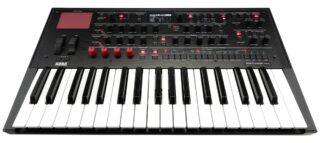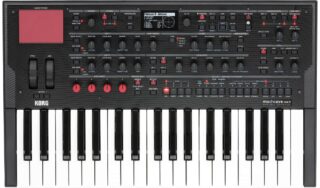Korg has introduced the modwave mkII – an update to the wavetable synth that offers nearly double the polyphony, expanded free-running LFOs, and more.
The modwave mkII provides 60 voices of polyphony – almost double the original modwave’s 32, – and all LFOs now have options for free running, delayed start, and retriggering. They’ve also added a pre/post switch for reverb sends, new modulation sources, and more.
In 1985, Korg introduced the DW-8000, a hybrid synthesizer that combined digital wavetables with analog filters. Korg says that the modwave builds on the DW legacy, featuring “deep wavetable oscillators, gorgeous filters, wildly flexible modulation, unmatched polyphony, comprehensive pattern sequencing, and immediately satisfying hands-on control”.
modwave also introduces two unique new tools for creating dynamic motion:
- Kaoss Physics combines an x/y Kaoss pad with modulatable game physics to create a responsive, interactive controller.
- Motion Sequencing 2.0 brings the organic, continuously evolving patterns of the wavestate’s Wave Sequencing 2.0 into the world of motion sequencing, including multiple lanes and real-time recording to help you create complex and evolving phrases.
Like the wavestate and opsix, the modwave synth engine offers a modern take on classic digital synthesis capabilities.
Korg modwave Audio Demos:
Features:
- modwave synthesis engine
- Kaoss Physics
- Motion Sequencing 2.0
- Deep synth engine, with a wide range of filter options, extensive modulation options, effecdt, randomization and more.
- Editor/Librarian software
- Set Lists and Smooth Sound Transitions
Pricing and Availability:
Korg modwave mkII is available now for about $700 USD.




Looks like it will have the same cheap feel as the mkI. Also: 60 voices of polyphony and “smooth sound transitions” – why can’t it be at least 2 part multitimbral?
Both the original modwave and the modwave mkII are 2 part multitimbral. Each layer A and B have separate FX chains, reverb send, key zone, velocity zone, and midi channel.
It is bi-timbral; always has been…
I’ll take “First Gen Perfectly Fine Synths” for $300 less, Bob.
I hope they put a better keyed in the MKII. The one on the first gen is absolute crap.
The trio this comes from is made up of jaw-dropping engines and butt-chapping builds. #1 on my list of killer synths that need a chop job away from their crap keybeds. I went for Wavestate native, so I get all of the Good and none of the KLACK.
Heh, yeah.
I was so blown away by WS Native that I bought a Wavestate. And an Opsix.
I sold both (after getting the 50% coupon for Opsix Native) after a few months because:
1. The keybed was one of the worst I’ve ever tried
2. Only 37 keys (I need 61. I can’t do without 61.)
3. No aftertouch
4. Small b/w display (well, that was not THAT important, but with the chassis color on all synths, everything was dim white-ish on black – ON black)
5. Seriously underpowered CPU
6. Plasticky, almost cheap ‘Made in China’ feel to the chassis
5. was the killer for me. Whereas Wavestate Native was snappy and seemingly with unlimited polyphony (yes, I know, I know) on my M1 Max, the hardware Wavestate took several seconds to load some patches before it was ready, and sometimes it behaved as if 6 note polyphony was max before it started stealing voices.
So they started to collect dust both of them as I used the Native versions anyway. It was a much better experience with a full 5 octave MIDI keyboard with decent keybed (Komplete Kontrol S61 MkII) and aftertouch.
Korg has the SE version which has all of your recommendations but costing over 300% more.
For those who hate the keyboard, there’s a desktop conversion kit (https://www.kickstarter.com/projects/loglow/desktop-conversion-kit-for-wavestate-opsix-modwave) for v1 Modwave, Wavestate, and Opsix. I’ve got two on the way. Kill the clack and reclaim some space!
Korg really insists on not releasing the desktop version.
Tried some Russian freeware versions of these three synths for some months, thinking these might bring some fun to the table. It totally killed my interest in each of these three synths, so I can move on from having opinions on these silly Mk2s. Not as deep as expected, which I count as a plus, yet without character. I had no fun with these. I hope Korg comes back with something interesting, as this is just rehash upon rehash, them coming down from the Kronon / Nautilus line.
I don’t think these three were really a re-hash; the engines were all serious improvements on the original approaches. If the builds were solid, then IMO, a lot more people would have one or two as worthwhile additions. They’d be especially useful for zoning and layering, above a synth that does splits, for example. Their basic voices deliver.